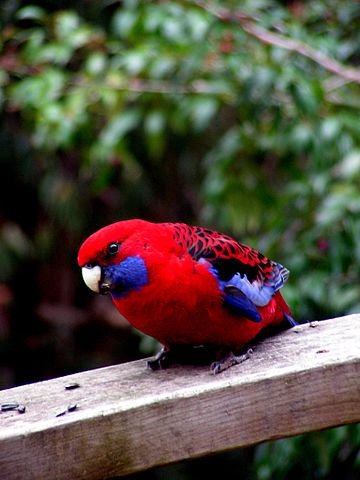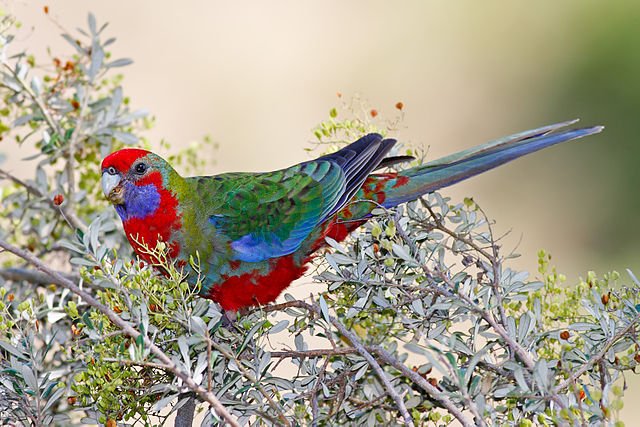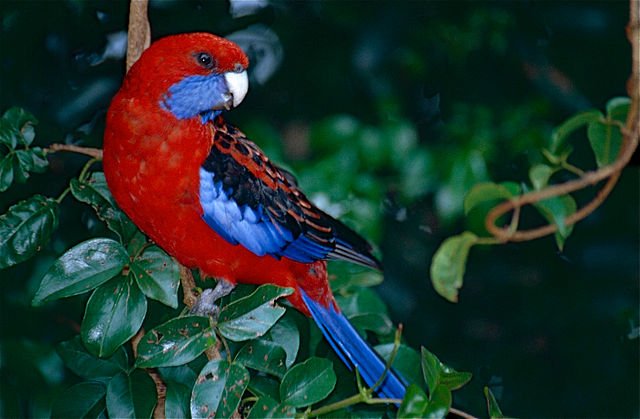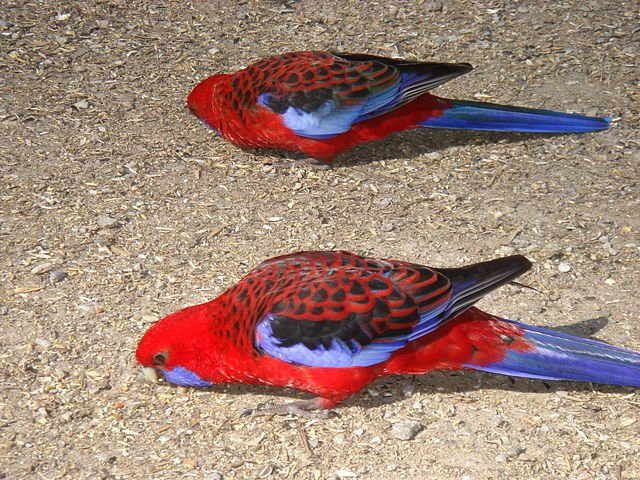When it comes to mesmerizing color patterns, no living being can beat parrots. Proudly flaunting their beautiful plumages, they probably know their much-loved beauty. Inhabiting the mountain and coastal areas are one such beautiful species, Crimson Rosella, whose patterned markings have gained them many names, both among avian lovers and breeders alike.
Crimson Rosella Color Taxonomy
The Crimson Rosella name covers three subspecies under one umbrella name. The colors of all these subspecies vary as much as they were thought to be altogether three different species in the past. But their subsequent biological study brought them under Crimson Rosella species. Let’s know them all for their colors and markings:
Crimson Rosella
Scientifically known as Platycercus Elegans, these subspecies are all crimson-colored Rosellas with slightly varied sizes. They are the most commonly found Crimsons across the globe. The subspecies, further, are a group of three subspecies namely;
- Platycercus Elegans Elegans – Commonly found in coastal areas of New South Wales and throughout Victoria, the male and the female have slight variations in the color markings.

photo credit: Jon-Eric Melsæter / CC BY (https://creativecommons.org/licenses/by/2.0)
The male has a dark red plumage with a rich purple or blue patch on the cheek. The back is black with spots of dark red. The wing bend and the outer covert of the wings are also rich purple/blue. The ends of the primary flight feathers and the tail feathers are also purple. The beak is grey/white. The tail is also blue with a slight white tip.

The female is similar to the difference in the tail’s color marking. The Female’s tail is washed with a dull tone of green with the underwing flaps being white. Also, the beak is relatively smaller.
When juvenile, they have an olive green plumage instead of the adult crimson plumage. The forehead and the crown are red and the cheek patches are also outlined with red. The breast area, throat, and thighs are light red. The tail is also olive green with white underwing stripe.

2. Platycercus Elegans Nigrescens – Commonly inhabiting the north-east coast of Queensland, this subspecies is the smallest of the three red-colored Crimsons. The colors and marking of both the male and the female Nigrescen are similar to that of the P.E. Elegans with the only difference that this subspecies has noticeably darker red plumage.
When juveniles, they do not get a green plumage as P.E. Elegans do. The plumage is crimson red but of a duller tone. The rump and its underparts are a dark shade of red along with a dark-red head. The breast feathers have lighter scalloping of black. The mantle and the back are black as in adulthood with red spots suffused with a lighter shade of olive green. Due to their dominating green plumage, they are sometimes also called Green Rosellas.

photo credit: Fir0002/Flagstaffotos
3. Platycercus Elegans Melanoptera – They mainly occur in Kangaroo Island and are the largest subspecies of all three Platycercus Elegans. The male and female are similar in all the colors and markings across the body. But their crimson plumage is a darker shade than P.E. Elegans and is almost similar to P.E. Nigrescens. But what distinguishes them from the latter also, is that the red margins on their black feathers on the mantle and back are narrower than the other two subspecies.
When juveniles, they look almost identical to the P.E. Elegans with the only size being the distinguishing factor.
Yellow Rosella
Scientifically known as Platycercus Elegans Flaveolus, they are commonly found along the Murray River and its several tributaries. The crimson color is replaced by a brighter pale yellow tone. Though the purple/blue color of the cheek patch and wings stays the same.
The frontal band and lores are orangish-red. The mantle and the back are black like Crimson Rosellas, but the red spots are replaced by the yellow ones. The rump and its underparts along with the upper tail coverts carry an olive/yellow tone.

Photo by Greg Hume
The Yellow Rosella juveniles have different color markings than that of adults. The frontal band is a bit narrower and is a rather paler shade of orangish-red. The upperparts are olive green with little spots on the mantle and the back. The rump and its underparts along with the upper tail coverts carry a dull olive/yellow tone as compared to the adults. The underwing stripe is white like juvenile P.E. Elegans.
Adelaide Rosella
Previously thought to be a different species, Adelaide Rosellas primarily inhabit Adelaide and the surrounding regions. Though still unclear, the subspecies is believed to be a hybrid, formed by the natural interbreeding of the Crimson and Yellow Rosellas in the wild. But studies still lack the proof to back it.
Scientifically named as Platycercus Elegans Fluerieuensis, the subspecies is different from the P.E. Elegans with both the male and the female having a pale to strong orangish-red plumage. The forehead, crown, and lores are all strong orangish-red in color.
The nape and the sides of the head are orangish-yellow. The cheeks carry a violet-blue color. The mantle and the back is greyish black with dull orangish-red spots. The breast and the abdomen are mostly yellow with a strong orangish-red tinge. The outer feathers of the tail are dark blue with pale and bright edges. And the under coverts of the tails are pale blue. The feet and beak both are greys.
The Adelaide females are smaller in size than their male counterparts and they are suffused with a more orangish tint. Their beak is also comparatively smaller and narrower.
The juveniles have an olive-green plumage except for crown, forehead, throat, upper cheek, upper breast parts, thighs, and under coverts of the tail. The wing coverts are also olive green with under coverts being dull blue. Similarly, the tail is also olive green with blue-black tips. The adult plumage is attained after a second molt at around 12 to 16 months of age.
Hybrids of Crimson Rosella
Apart from the three main species and their further variations, there are a few known hybrid varieties of Crimsons due to their natural inbreeding in the wild. Some of the few commonly occurring hybrids are the following:
Platycercus Elegans Sub Adelaide
This is the scientific name given to the hybrid species of a Crimson Rosella and an Adelaide Rosella. Both the male and the female Sub Adelaide have orangish-red crown, forehead, and face. The frontal band is a brighter shade of red. The underparts are generally a pale shade of yellow washed with a duller orangish-red tinge. The mantle and the back are black and have spots of a dull yellow color. The lower back and the tail coverts are of olive green color.
Read about Pale-headed Rosella here
https://parrotquaker.com/all-about-pale-headed-rosella/
When juveniles, they look a bit similar to juvenile Adelaide Rosellas. But there still exists some distinguishable color markings. The juveniles have a comparatively pale green plumage with the dominance of yellow except crown, forehead, upper cheek, upper breast parts, thighs, and under coverts of the tail that are a dull shade of orangish-red. The frontal band is a bright shade of orangish-red with a dull yellow-orange throat area. The purple/ blue patches on the cheek are outlined with a rather dull orangish-red tone.
Platycercus Elegans Fluerieuensis X Elegans Sub Adelaide X Flaveolus
The hybrid can be explained by its scientific name itself. Both the male and female have an orangish-red plumage with slight variations. The crown, forehead, and the lores have an orangish-red color. The sides of the head and the nape are orangish-yellow. The mantle and the back are black with an orangish-red tinge with olive-yellow scallop markings on them. The lower back is olive-yellow that merges with the orangish-yellow tone of the rump and the upper tail coverts. The tail is purple/blue with a white tip and the under coverts are all washed with an orangish-red tinge.
When juvenile, they have a prominent olive-green plumage of a duller shade. The crown, forehead, throat, upper breast parts, thighs, and under coverts of the tail are all of the varying hues of orangish-yellow to a duller shade of orangish-red. This lends them a beautiful ombre kind-of plumage. The rump and the upper coverts of the tail are of olive-yellow tone. The tail is olive-green.
Final Words
Crimson Rosellas owe their fame and popularity to their mesmerizing colors. And they surely have a full color-palette covered. As if this was not enough, the breeders have attempted quite a few successful color mutations of Crimsons that have made the alternatives list longer. Ranging from the brighter shade spectrum like pastel blue and blue, breeders have successfully attempted soft color mutations like albino and silver.
Where some of the color mutations are easily bred by many breeders, few of them like Silver Crimson Rosella is rare due to various complications during their breeding process. That makes some of these color mutations a rare sight.
But the vivid colors of all the original subspecies have kept all the pet lovers more than enchanted and it has hardly given them a chance to opt for the Crimson’s color mutation varieties.
Read more about Crimson Rosella in wild:
https://parrotquaker.com/crimson-rosella-in-wild/
Featured Image credit: Bernard DUPONT from FRANCE / CC BY-SA (https://creativecommons.org/licenses/by-sa/2.0)



